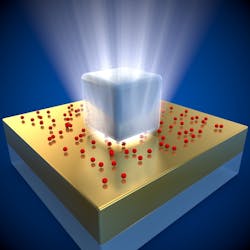Ultrafast quantum-dot emitter could be new communications/computing device
Duke University (Durham, NC) researchers have developed an ultrafast light-emitting plasmonic device that can flip on and off 90 billion times a second and could form the basis of optical computing. While lasers can fit this requirement, they are too energy hungry and unwieldy to integrate into computer chips.
RELATED ARTICLE: Plasmonics enters practical WDM switching applications
Although billions of transistors use electrons to flip on and off billions of times per second, microchips that use photons instead of electrons to process and transmit data could allow computers to operate even faster. Duke University researchers are now one step closer to such a light source.
In a new study, a team from the Pratt School of Engineering pushed semiconductor quantum dots to emit light at more than 90 gigahertz (GHz). The study was published in Nature Communications.
"This is something that the scientific community has wanted to do for a long time," said Maiken Mikkelsen, an assistant professor of electrical and computer engineering and physics at Duke. "We can now start to think about making fast-switching devices based on this research, so there’s a lot of excitement about this demonstration."
The new speed record was set using plasmonics. When a laser shines on the surface of a silver cube just 75 nm wide, the free electrons on its surface begin to oscillate together in a wave. These oscillations create their own light, which reacts again with the free electrons. Energy trapped on the surface of the nanocube in this fashion is called a plasmon.
The plasmon creates an intense electromagnetic field between the silver nanocube and a thin sheet of gold placed a mere 20 atoms away. This field interacts with quantum dots—spheres of semiconducting material just 6 nm wide—that are sandwiched in between the nanocube and the gold. The quantum dots, in turn, produce a directional, efficient emission of photons that can be turned on and off at more than 90 GHz.
"There is great interest in replacing lasers with LEDs for short-distance optical communication, but these ideas have always been limited by the slow emission rate of fluorescent materials, lack of efficiency and inability to direct the photons," said Gleb Akselrod, a postdoctoral research in Mikkelsen's laboratory. "Now we have made an important step towards solving these problems."
"The eventual goal is to integrate our technology into a device that can be excited either optically or electrically," said Thang Hoang, also a postdoctoral researcher in Mikkelsen's laboratory. "That's something that I think everyone, including funding agencies, is pushing pretty hard for."
The group is now working to use the plasmonic structure to create a single photon source—a necessity for extremely secure quantum communications—by sandwiching a single quantum dot in the gap between the silver nanocube and gold foil. They are also trying to precisely place and orient the quantum dots to create the fastest fluorescence rates possible.
Aside from its potential technological impacts, the research demonstrates that well-known materials need not be limited by their intrinsic properties.
This work was supported by the Air Force Office of Scientific Research Young Investigator Program (AFOSR, Grant No. FA9550-15-1-0301), the Air Force Office of Scientific Research (AFOSR, Grant No. FA9550-12-1-0491), an Oak Ridge Associated University’s Ralph E. Powe Junior Faculty Enhancement Award, the Lord Foundation of North Carolina, and the Intelligence Community Postdoctoral Research Fellowship Program.
SOURCE: Duke University; http://pratt.duke.edu/news/superfast-fluorescence-sets-new-speed-record

Gail Overton | Senior Editor (2004-2020)
Gail has more than 30 years of engineering, marketing, product management, and editorial experience in the photonics and optical communications industry. Before joining the staff at Laser Focus World in 2004, she held many product management and product marketing roles in the fiber-optics industry, most notably at Hughes (El Segundo, CA), GTE Labs (Waltham, MA), Corning (Corning, NY), Photon Kinetics (Beaverton, OR), and Newport Corporation (Irvine, CA). During her marketing career, Gail published articles in WDM Solutions and Sensors magazine and traveled internationally to conduct product and sales training. Gail received her BS degree in physics, with an emphasis in optics, from San Diego State University in San Diego, CA in May 1986.
